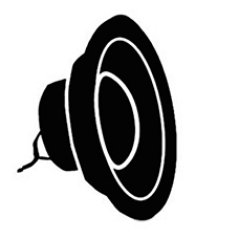Maverick Music from Auckland:
Vitamin S in context
By Colin Woods
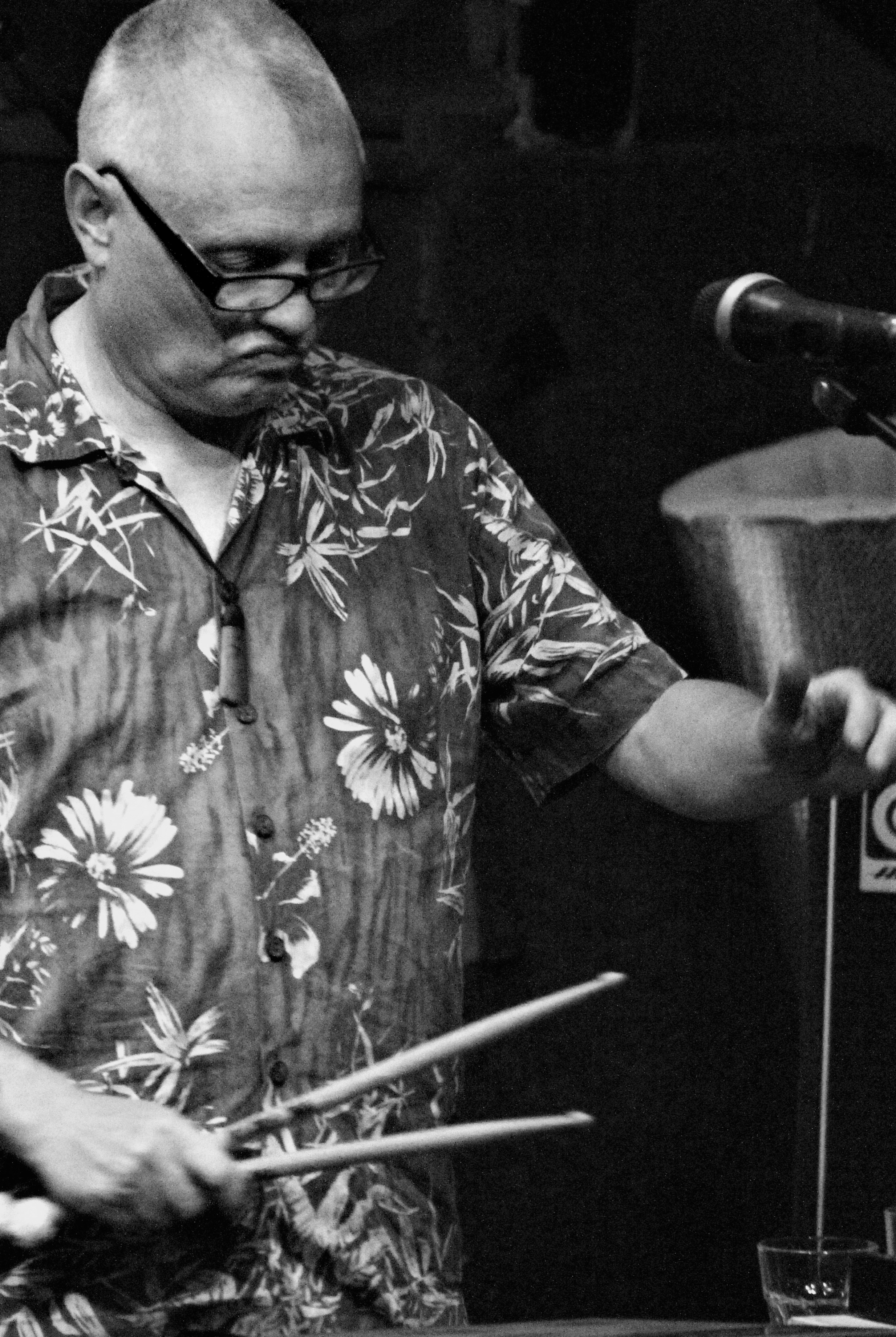
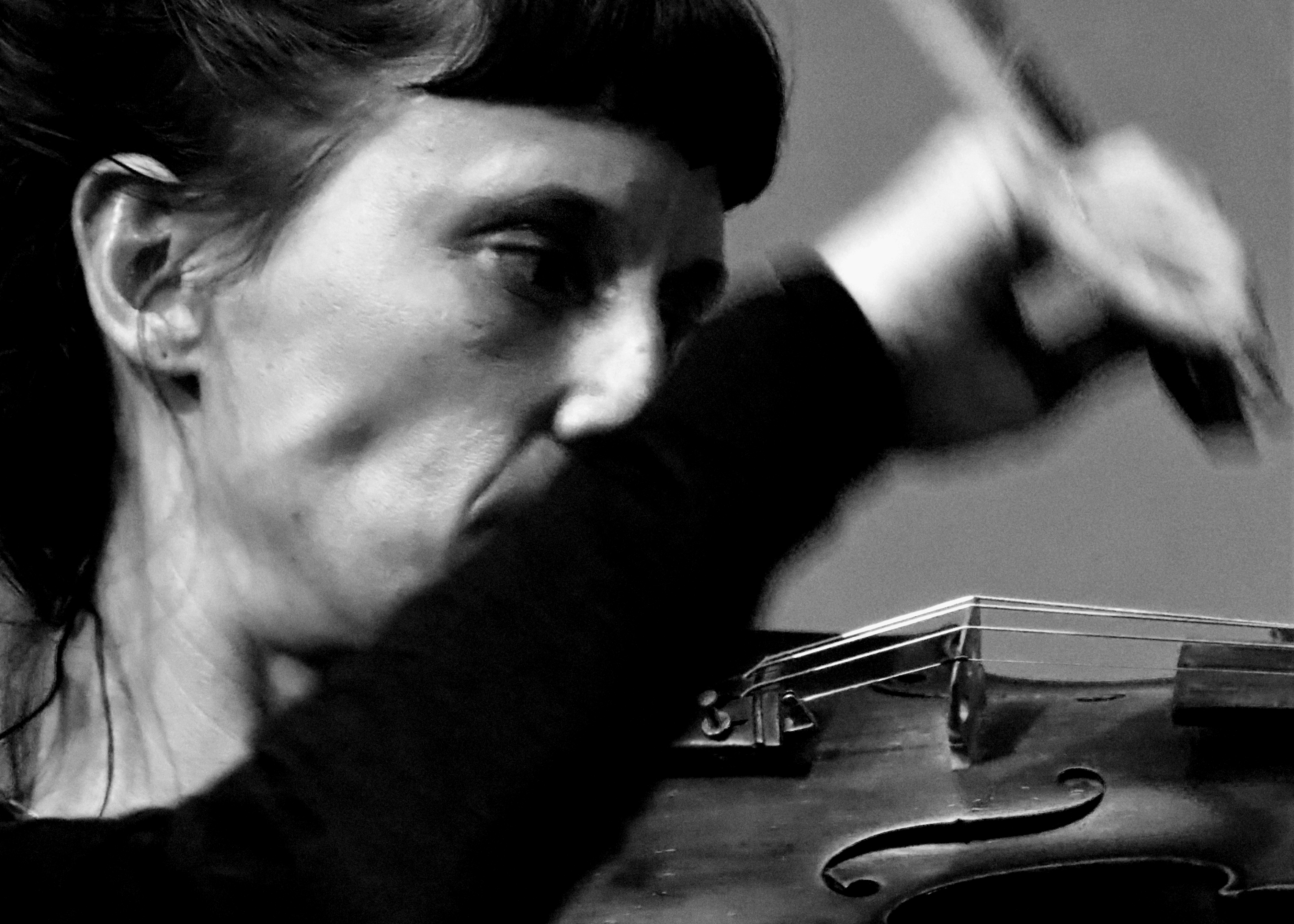
"Writing is always making explicit at the expense of other things. Mystery is
sacrificed, and consequently truth and so everything.”
Pierre Schaeffer, January 19481
Coming Home
One dark, damp Monday night in late 2006, I went for a walk. I had recently moved from
Wellington to Auckland after taking up a job in the pathology laboratory at Auckland City
Hospital. As a temporary measure, I was living in a grim (but cheap) hostel near the Hospital.
My walk took me along Karangahape Road and down the steps of St. Kevin’s Arcade. There
I discovered a world that was both literally and metaphorically underground – The Wine
Cellar, run by the legendary Rohan Evans; and the amazing event that is the Vitamin S pool
night – Auckland’s local manifestation of non-idiomatic free improvisation.2 I became a
regular visitor to both and quickly a participant in the latter. Both were full of my sort of
people, all weird in their own way, and, without exception, friendly. In a very real way, it was
like coming home. To say that this changed my outlook in life would be an understatement,
as it re-ignited my lifelong passion for experimental music forms and introduced me to a
name for a particular subset of this activity - non-idiomatic free improvisation.
Making it up as a form of being/knowing
Former member of The Flying Lizards and academic David Toop opens his book Into the
Maelstrom thus: “Humming in the background of all life - and familiar and alien as
breathing- is improvisation.”3 Early 20 th Century American experimental composer Charles
Ives also talks of this ubiquity of sonic experience, and his hopes for it to become recognized,
in his postface to his 1922 collection 114 Songs; imagining individualised symphonies and
sonatas arising from mundane activities and the natural landscape.4
My own practice is informed by the idea that improvisation is a form of embodied
knowledge in and of itself, as suggested by Daniel Fischlin and Eric Porter in their
introduction to their recent (2021) collection of essays, Sound Changes.5 Siddall and
Waterman describe it as, “a form of knowledge creation through expressive practice.”6 Pierre
Schaeffer (see quote above) understood how writing about the experience of experimental
music was plagued with inadequacies. Thus, the true knowledge resides in the work, or the
performance. Essentially, this echoes the general position of art as a valid mode of embodied
knowledge as expounded by British philosopher Louis Arnaud Reid.7 As Taranaki artist
Rangi Kipa (Te Ātiawa, Taranaki, Ngāti Tama ki te Tauihu) puts it, “[a]rt is about our
relationship with our immediate environment. It is part of our everyday and the way we
express ourselves and our belief systems.”8
Non-idiomatic Free Improvisation
So-called non-idiomatic free improvisation (NIFI) as a genre (or perhaps anti-genre) has
its modern roots in the 1960s, with the London groups AMM and the Joseph Holbrooke Trio.
As there is controversy around the idea of NIFI as a genre, I propose to reframe it as a
practice.
Joseph Holbrooke’s Derek Bailey (one of the practice’s most widely acknowledged
originators) makes a convincing argument that it is actually the most ancient form of music
making.9 He also asserts, “Improvisation enjoys the curious distinction of being both the most
widely practised of all musical activities and the least acknowledged and understood.” Ben
Watson describes him as “an avant-garde extremist, an enragé and a cunning saboteur of the
overground.”10
Watson, in the introduction to his book charting the history of Bailey’s involvement in the
scene, positions the practice as a reaction against the commodification of art saying, “It’s a
movement! It’s an ethos. Unlike rock and punk and drum’n’bass, it can’t be bought and sold
by capitalism, it can’t be ripped off by A&R sharks or managed by managers.”11
Bailey also makes similar assertions about the untamability of the genre at various points
in the interviews in the book and bewails the demise of real live music versus the drive for
bands in working-class venues to play cover versions of hit records. It’s clear from the
interviews he was saddened by the large-scale replacement of live music generally and its
attendant dance-hall culture by 60s discotheques.
One should point out here that improvisation has been an essential part of many musical
traditions in different cultural settings, and Bailey surveys some of this in his book. He
examines Indian music, Flamenco, Baroque, French Organ School, Jazz and Rock in addition
to free improv. In French Organ School practice, the improvisations are usually performed to
accompany the Roman Catholic liturgy and sacraments. According to Bailey’s interview with
practitioner Stephen Hicks, the music is deliberately ephemeral, designed to just be in the
background to the theatricality of the mass. Hicks is reported as saying, “It’s something that
should be heard, enjoyed or otherwise, and then completely forgotten.”12 For me this is
evocative of Erik Satie’s ‘Furniture Music’, a form that was explicitly designed not to be
listened to, but rather to blend inconspicuously into an occasion becoming part of the
environment rather than a foreground to be attended to. Michael Nyman quotes Satie as
saying, “Furniture music creates a vibration; it has no other goal; it fills the same role as light
and heat - as comfort in every form.”13
In the Baroque period, however, a lot of music was written in figured bass notation.
Players were expected to infer a harmonic structure and provide suitable melodic content -
including the expectation that they would ad lib ornamentation. Different performances of the
same score would not be identical. This point about scores in general (not just figured bass) is
also made by Umberto Eco in his influential essay The Poetics of the Open Work.14
Bailey also examines the unsurprising relationship between composition and
improvisation. My conversations over the years with other New Zealand composers lead me
to think that this link is not unusual. Interviewed by Radio New Zealand’s Brian Crump in
June 2022, New Zealand composer Antony Ritchie let slip that, “I still get my ideas
improvising and working at the piano.” 15
Only recently has the realm of free improvisation and ‘noise music’ had any serious
academic attention. Genres of ‘popular’, outsider, and folkloric music have often been
deemed less worthy of attention than institutionally designated ‘serious art’ by the academic
establishment. Even popular critics and reviewers tend to give it short shrift: The New
Yorker’s music critic, Alex Ross, gives the free improv scene only a fleeting mention with a
less than flattering paragraph about Cornelius Cardew16 in his wide ranging and popular
review of twentieth century music, The Rest is Noise.17 There might be a clue to his attitude in
the title. Bruno Nettl also alludes to this historical lack of attention in the introduction to In
the Course of Performance.18 Even in the experimental realm of Electroacoustic music there
has been a paucity of attention to improvisational practice and this is acknowledged in a 2021
editorial to the journal Organised Sound.19 Fischlin and Porter track the study of improvised
music as only really gaining any serious traction in the early twenty-first century.20
American composer and performer Vijay Iyer contends that this virtual exclusion from
the academic mainstream of NIFI is a reflection of a kind of institutionalised racism which
seeks to place other music forms in hierarchical layers below the prevailing paradigm of
Western classicism. He says,
Improvisation has been construed as Western art music’s Other… The decision to
exclude improvisation as inherently unstable is not neutral, but is bound up with
the endemic racism that has characterized social relations in the West and that is
being brought to the fore in Black Lives Matter and other recent social and
political movements.21
So, just like the participatory theatre analysed by Claire Bishop in her analysis of
experimental and participatory theatre, Artificial Hells, NIFI might be regarded as having
a political dimension embedded in its philosophy. Her characterisation positions the theatre
practices discussed as artforms having a resistance to economic commodification. 22
In their prelude to their review of improvisatory music, The Fierce Urgency of Now,
Fischlin, Heble and Lipsitz also explicitly make this connection, saying, “We have come to
conceive of musical improvisation as a generative yet largely unexamined model for political,
cultural, and ethical dialogue and action.”23 Although this ties in with Iyer’s comments, not
everyone is completely convinced about this political framing: Gary Peters, for example,
asserts a critique that fundamentally contradicts this criticising many of what he considers to
be flawed assumptions in Watson’s book.24 He compares Bailey to Samuel Beckett (whom
Bailey admired) in celebrating a certain lack of discernible narrative content. But I think
Peters’ essay is too focused on the content the performance and so misses the point
somewhat. Bailey, interviewed in 1975 fully admits that the content of NIFI (as opposed to
the form or its practice) is not suitable for communicating any sort of political messaging, or
in fact communicating any sort of message other than the music itself.25 Earlier in the same
interview says rather dismissively, “Anyone interested in communication should spend time
digging holes for telegraph poles.” I rather compare the undertaking NIFI as an activity as
akin to Dadaist poetry; in that the lack of content with any literal meaning is a statement in
itself.
In their 2021 book, Sound Changes, Fischlin and Porter position improvisatory practice
as more than just performance, describing how it is, “a model, not without challenges and
caveats, for political, cultural, and ethical dialogue and action- for imagining and creating
alternative ways of knowing and being known in the world.”26 I note here that this idea of
improvisation as a form of embodied knowledge is key to an analysis of the realm and in
retrospect has informed my personal practice generally.
Interviewed in Watson’s book, Joseph Holbrooke drummer Tony Oxley, on the other
hand, was very clear about the class aspect of what he was doing:
My Music is basically political by its existence, because it can’t deny the
background. If you come from such a place as we come from, you do
understand the functions and the different strata of society. We knew what
we were - down there - doing more or less what we were told, or starve.27
![]()
![]()
![]()
Aotearoa /New Zealand
The most prominent local manifestation of NIFI is the Auckland-based collective Vitamin
S, as I discovered to my delight back in n that rainy night in 2006. It was founded in 2002 by
composer and performer Andrew (Drew) McMillan after brainstorming the concept and
format with fellow musician Kingsley Melhuish on the long car journey back to Auckland
from a festival in Wellington.28 Drew continues to be a central pillar of the enterprise, keeping
it chugging along through the COVID pandemic and various other challenges.
According to their website it is, “A community of artists engaged in the dialogue of
creative improvisation.”29 It continues,
The Vitamin-S pool night was devised as a place where those interested in
improvised music and performance could meet, perform, listen to and
discuss, and generally interact with all aspects of this complex and largely
misunderstood art form.
The website goes on to make the following distinction:
︎ Idiomatic improvisation: much the most widely used and concerned
with the expression of an idiom - jazz or flamenco for example, and
taking its identity and motivation from that idiom.
︎ Non-idiomatic improvisation: here other concerns are fundamental. It
is usually found in so-called 'free' improvisation.
…emphasising that it is the latter form that is the focus of the group.
The definitions are very close to the form of words stated in Derek Bailey’s review of
improvisatory practices.30 Paul Buckton confirmed to me recently that this was in fact the
source for the text. As with the scene generally, there is a distinct paucity of scholarly
literature that describes or analyses the Vitamin S collective specifically.
This seems unfair, as my personal encounters with Vitamin S and its connected scenes
have led me to reassess my own approach to creativity, and given me opportunities to
express that, both via direct participation in the pool nights, and at other events. I contend that this
energising and empowering effect is not confined to me and deserves greater recognition,
documentation, and scholarship.
Vitamin S gets a passing mention in Home Land and Sea,31 and the group does have its
own Wikipedia entry where it is described as, “as a free improvisation collective” and “non-
profit collective”.32 Other than that, very little seems to exist, especially in the peer-reviewed
realm. Glenda Keam, former head of music at University of Canterbury and an occasional Vitamin S
participant herself, presented a short paper at the New Zealand Musicological
Society Conference 2011, based on interviews and observations conducted at four Vitamin S
evenings (she kindly shared her notes with me). She described the regular members as “an
interesting bunch, many of whom may also be seen and heard regularly performing as
musicians in other scenarios around town, building sculptures or teaching art, or working in
the caring professions.” 33
I previously conducted a short research paper based on structured interviews with a
selection of Vitamin S participants.34 My own (biased) observation, however, is that the
participants are overwhelmingly middle-aged, middle class white males with a tendency to
left leaning political outlook.35 Some of those observations are consistent with those of Keam
in her research; she points out, “Across the four Mondays, there were no female performers,
only male…Two thirds of the respondents [to her study] were Pakeha [sic] New Zealanders”
It was also my observation that, during the time I was a Composition student at
University of Auckland School of Music (2010-15), there was practically no interaction
between existing students (with the exception of a few from the jazz stream) or staff and Vitamin S;
and very little awareness of it as a thing (honourable exceptions: composers Eve
de Castro Robinson and John Coulter, and early music expert Kevin Kim). In contrast, it
seemed to me that there was more interest from Visual Arts students.
There is a chapter about Vitamin S in Bruce Russell’s Erewhon Calling36 (although in his
introduction to that book Russell points out that “… ‘music’ in New Zealand generally is
poorly served in terms of publications”) and the group itself produced a small informative
zine to celebrate its tenth birthday.37 Both of those accounts are largely concerned with
outlining historical information. The chapter in Russell’s book gives insight into the kaupapa
of the group:
There is no discussion, there is no rehearsal and there is no ‘let’s try that again’…
it is not an open mic night or jam session, it is not a place to try out composed
music, and it is not place which excludes performers from any musical genre.38
![]()
![]()
![]()
The 10 Year anniversary booklet contains a wealth of information about the history of the
group. Of note is the interview with founder Andrew (Drew) McMillan and Paul Winstanley
(once a regular participant but now relocated to the US) in which they discuss the origins of
the collective and its ethos. Their initial venue was the (now defunct) Odeon Lounge, then the Wine Cellar,
then the (now defunct) Luxembourg Gardens39 and is now firmly ensconced in
the Wine Cellar, with occasional forays to other venues (Including the Audio Foundation) for
special events.
The booklet also contains personal statements from participants about the practice of
NIFI that reinforce the idea of an inherent political framing locally. Renowned percussionist
Chris O’Connor comments, “[non idiomatic improvised music] represents the possibility of a
model society I am excited by.”40 Paul Buckton: “Every decision you make about your life
and how you live it is political.”41 Darren (Darridge) Hannah: “Improv is tied to broader
forms of democracy, in its social nature and rejection of hierarchy…Improv is inherently
political in nature, and its politics happen to match mine.”42
What happens at Vitamin S cannot be called ‘popular’ (typical audiences range from 5 to
20 people, in my experience) but neither has it been taken on board as serious art music in
terms of scholarly study in New Zealand. This is despite the fact that a good proportion of
those involved are professional musicians or art school graduates. Nevertheless, the group
has had small amounts of funding over the years from Creative New Zealand. This “outsider
music” is always on the edge.
Vitamin S has worked closely with the Audio Foundation. Founded in 2004 by Zoe
Drayton, the Audio Foundation exists “to support, promote and preserve ‘Sound
Art’ /’Experimental Music’ / ‘Noise’ / ‘Drone Music’ etc in NZ.”43 The Audio Foundation’s
current director, Jeff Henderson, is a frequent participant in Vitamin S, and was previously a
key figure in the experimental music scene in Wellington.
The range and background of the participants in Vitamin S is varied. It encompasses jazz
players, classically trained orchestral players, pop musicians, performance artists,
contemporary dance practitioners, and sonic artists, through to ‘outsider’ musicians with
limited formal training. There is no qualification bar to participation other than a willingness
to perform in a randomly constituted ensemble without rehearsal or pre-planning.
Keam, however, points out that the very idea of “non-idiomatic” is slightly problematic.
She reports Eddie Prévost (a founder member of the group AMM) as thinking that because the
general ‘sound’ produced starts to become recognisable, then it is, in effect, a new idiom.
Writing in No Sound Is Innocent, Prévost comments, “the conventions and practices that have
as risen in AMM are its signatures. They are signs of its identity: perhaps also of traps AMM
has failed to avoid.”44
On the other hand, (referring to AMM in particular), music writer Philip Clark disputes
that there is any consistent identifiable idiom or sound going on to say, “AMM… taps into a
centring flow of sound, which the musicians, as responsive listeners, can either uphold or
shift towards new ground. Each musician represents a separate layer of overlapping activity,
and the music procreates an accumulative structure as these jagged layers dance in
counterpoint to each other.”45 In my experience, this is also a pretty good description of a
typical Vitamin S set.
Bailey’s collaborator in the Joseph Holbrook Trio, drummer Tony Oxley also had doubts
about how “free” free was. He is reported in Watson’s book as saying:
The implication of free music is anything goes. You can say, do what you
like. But of course you are doing what you like, but what you like is not
just thrown in because you yourself don’t know what to do. You have what
you’re doing under control. You build a language and you work with that
language, you improvise with that language - hopefully it develops as you
go along.46
...which kind of reinforces what Keam asserts and one might relate this to Simon
Emmerson’s notions of action repertoire in relation to composition.47 Many of the people in
the Vitamin S scene have said to me that there is a certain ‘Vitamin S Sound’, so really it
depends on your own experience.
One of the central figures in the Vitamin S scene since its early days, Paul Buckton, (who
often acts as master of ceremonies and performs often on guitar and occasionally violin or
cello) serves as a direct link back to the UK scene that crystallised around Bailey, having
been involved in The Termite Club in Leeds in the 1980s. The Termite Club described itself
as “Maverick music from Leeds” and appears to have been briefly revived in 2014 (according
to an archived web page from Vibrations magazine).48
There are other improvised music scenes here in Aotearoa/New Zealand, notably in
Wellington (The Sound and Light Exploration Society and its related Pyramid Club); 49
described in a recent newspaper article as “legendary”.50 Until 2017, Christchurch had a
group based around The Auricle Gallery.51 Individuals from those groups (and from further
afield) have often been guest performers at occasional events or workshops organised by the
Vitamin S collective, and various Vitamin S participants have been invited to perform at
events and festivals organised by those groups.
This year (2022), Vitamin S celebrated its 20th anniversary with an exhibition at the
Audio Foundation, described as “an exhibition charting the history and development of this
grass-roots collective.”52 There were two accompanying limited-edition booklets produced in
house at the Audio Foundation - a photo book,53 and the transcript of a revealing interview
with Paul Buckton from 2012 (see below).54
![]()
![]()
![]()
The Photo Book
(Full disclosure: there was a photo of me in the exhibition and one in the book) Paul
Buckton is fond of the following quote, which (via Darren Hannah) he attributes to Bill
Watterson’s cartoon strip Calvin and Hobbes, to sum up the ethos of the group, it’s
reproduced in the Photo Book on the page before the pictures start. I find it amusing that
Waterson’s scenario, whilst attempting to satirise avant-garde music, ends up being embraced
as a form of truth.
Our music is about the inadequacy of traditional imagery and symbols to convey
meaning in today’s world. By abandoning representationalism we are free to express
ourselves with pure form. Specific interpretation gives way to a more visceral
response.
The main exhibition consisted of photographs taken over the past 20 years, mostly by
Paul Buckton, but with some contributions by long-time Vitamin S stalwart Derek Tearne.
They were all taken at pool nights or special events organised by the Vitamin S core team.
The collection movingly includes some performers who have sadly passed on. Faces familiar
to those outside the Vitamin S community in the collection include Phil Dadson, Richard
Nunns, Steve Beresford, Chris O’Connor, Rob Thorne, and Jim Langabeer. Naturally,
Drew’s recently departed service dog Biff, a much -loved serial and stoic attender of pool
nights, also features. The scope of photos in the book makes it a significant archival
document. As the exhibition website put it, “…these documents, snapshots in time, moments
out of order — grainy, blurry, blown-out, full of energy — provide a glimpse into this
community, their music and comradeship.”
![]()
![]()
![]()
![]()
The Buckton Interview55
Paul Buckton is very much a cornerstone of Vitamin S, having been key participant since
early times of the group, in the cohort along with composer Andrew McMillan and Darren
Hannah. He ca
me to New Zealand to work as a teacher in 1997. At that stage he’d given up
playing after being involved with The Termite Club in Leeds for many years. Buckton, along
with his colleague Alan Wilkinson, had been instrumental in getting Termite up and running,
only ending his involvement after becoming disillusioned with the attitude of some of the
out-of-town players, who did not, it seems, fully acknowledge the work that went into
keeping it running, and took the hospitality of Paul and his family for granted. It would be
five years before the urge to play returned. In the interview, Buckton outlines the evolution of
Termite from a monthly gig night for alternative bands to a forum that focused more and
more on improvisation, name-checking Evan Parker, Steve Beresford, and Derek Bailey
along the way.
Buckton also describes playing violin with the Portsmouth Sinfonia in the mid 1970s,
travelling to London and meeting guitarists Derek Bailey and John Russell, and other people
in that scene.56 He says of the Sinfonia, “I would just sit there with 50 other people pretending
we could play this popular classical shit.”57 Buckton’s time with the Sinfonia included gigs at
the Royal Albert Hall.
Of his approach to creating improvised music he says, “you have to leave all your ideas
about what music is behind and just play.”58 He goes on to refer to Bailey’s idea that if too
many people started liking the performances, then somehow you have missed the point.
He considers Rohan Evans’ role in the stubborn persistence of Vitamin S to be very
important, “in all my improvising days, I’ve waited until I got to the Wine Cellar to find
somebody who owned a bar, and was into the music.”59 This is in contrast to his experience
with Termite in Leeds, where he recalls using “14 pubs in 12 months.” Even the COVID-19
pandemic could not suppress the enthusiasm of the group, as activities and pool night moved
to the virtual space of the internet and were live-streamed with pool participants in separate
locations, until the Wine Cellar was able to open again.
I should point out here that Vitamin S performances are often not confined to the realm of
sound. There is sometimes a component of deliberate visual theatre – whether this is the
object manipulation of sculptor John Radford (whose performances have included household
appliances, balloons, and coloured balls) or the involvement of various contemporary dancers
such as Georgie Goater, Val Smith, and Jess Quaid. Award winning dancer and
choreographer Kristian Larsen has been involved with the group since its early times and was
responsible (along with Drew McMillan) for a successful series of spinoff events entitled
Bangers and Mash in which each iteration saw two duos of musician pool members
collaborating with a dancer in an unscripted performance. McMillan has however expressed
the view that although it was easy to get musicians to participate in the dance events, it has
been harder to get the dance community to come along to Vitamin S pool nights.60
In Auckland, we are truly blessed that that particular set of individuals led by Drew
McMillan persevered to make the initial concept an ongoing and robust reality. Perhaps the
real key to the endurance of Vitamin S is its ability, on a rainy Monday night, to allow us to
be amongst friends and to focus on the frank and deliberate manifestation of this most human
and ancient of artforms, our small way of creating stubborn ripples across the degenerating
rhizomes of society, and to have a beer at the same time.
![]()
![]()
![]()
![]()
Acknowledgements
This writing is mostly based on work done as part of my research at AUT. I’d like to
thank the many participants in Vitamin S whose formal and informal discussions over several
years have helped me with this piece, including but not limited to: Drew McMillan, Paul
Buckton, Darren Hannah, and Audio Foundation Director, Jeff Henderson; also, Dr Nabeel
Zuberi (University of Auckland) for supervising some original research in 2015; Dr Glenda
Keam for sharing her conference paper notes; and my current PhD supervisors at AUT, Dr
James Charlton and Prof. Chris Braddock.
Colin James Woods
August 2022.
Photographs by Paul Buckton
1 Pierre Schaeffer, In Search of a Concrete Music, trans. Christine North and John Dack (Berkeley: University of
California Press, 2012), 3.
2 The Wine Cellar is an established bar and music venue which has been owned by Rohan Evans and his family
for 18 years. Rohan is famous locally as a tāonga of the local music scene, and for giving encouragement to
new bands, especially less popular and experimental genres. It gets its own chapter in Erewhon Calling.
3 David Toop, Into The Maelstrom: Music, Improvisation and the Dream of Freedom, 1st ed. (London:
Bloomsbury, 2016), 1.
4 Charles Ives, 114 Songs (Conn.: Redding, 1922).
5 Daniel Fischlin and Eric Porter, eds., Sound Changes: Improvisation and Transcultural Differences (Ann Arbor,
MI: University of Michigan Press, 2021).
6 Gillian Siddall and Ellen Waterman, eds., Negotiated Moments: Improvisation, Sound, and Subjectivity
(Durham: Duke University Press, 2016), 3.
7 Louis Arnaud Reid, ‘The Arts Within a Plural Concept of Knowledge’, in The Symbolic Order, ed. Peter Abbs
(London: The Falmer Press, 1989).
8 ‘Tohu Wakatipu (Exhibition)’ (Hundertwasser Art Centre, Whangarei, 2022).
9 Derek Bailey, Improvisation: Its Nature and Practice in Music, Rev. Ed. (London: British Library National Sound
Archive, 1992).
10 Ben Watson, Derek Bailey and the Story of Free Improvisation, Paperback edition (London ; New York: Verso,
2013), 2.
11 Watson, Derek Bailey and the Story of Free Improvisation, 3.
12 Bailey, Improvisation, 35.
13 Michael Nyman, Experimental Music: Cage and Beyond (Schirmer Books, 1974), 31.
14 Umberto Eco, ‘The Poetics of the Open Work’, in Participation: Documents of Contemporary Art, ed. Claire
Bishop (MIT Press, 2006).
15 ‘Nights’ (Radio New Zealand National, 22 June 2022),
https://www.rnz.co.nz/national/programmes/nights/audio/2018846887/dunedin-youth-orchestra-audrey-
reid-composition-competition.
16 Cardew was at various times a member of AMM.
17 Alex Ross, The Rest Is Noise - Listening to the Twentieth Century (New York: Farrar, Straus and Giroux, 2007).
18 Bruno Nettl and Melinda Russell, In the Course of Performance: Studies in the World of Musical Improvisation
(Chicago: University of Chicago Press, 1998).
19 James Andean, ‘Editorial: The Sonic and the Electronic in Improvisation’, Organised Sound 26, no. 1 (April
2021): 1–4, https://doi.org/10.1017/S1355771821000182.
20 Fischlin and Porter, Sound Changes.
21 Vijay Iyer, ‘Beneath Improvisation’, 2015, 1.
22 Claire Bishop, Artificial Hells: Participatory Art and the Politics of Spectatorship (Booklyn, NY: Verso, 2012).
23 Daniel Fischlin, Ajay Heble, and George Lipsitz, The Fierce Urgency of Now: Improvisation, Rights, and the
Ethics of Cocreation (Durham: Duke University Press, 2013), 1.
24 Gary Peters, ‘Bits and Scraps: Derek Bailey and the Improvised Situation’, in Improvising Improvisation: From
Out of Philosophy, Music, Dance, and Literature, (University of Chicago Press, 2017).
25 ‘Derek Bailey | the Interview | London 1975’, Bells | Free Jazz Journal by Henry Kuntz (blog), 25 May 2007,
https://bells.free-jazz.net/bells-part-two/derek-bailey-the-interview-london-1975/. 8
26 Fischlin and Porter, Sound Changes, 3.
27 Watson, Derek Bailey and the Story of Free Improvisation, 12.
28 Darren Hannah, ed., Vitamin S 10 Year Anniversary, Book, Edited (Auckland: Vitamin S, 2012).
29 Vitamin-S, ‘Vitamin-S’, 2021, http://www.vitamin-s.co.nz/about.php.
30 Bailey, Improvisation. xi
31 Glenda Keam and Tony Mitchell, Home, Land and Sea: Situating Music in Aotearoa New Zealand (New
Zealand: Pearson, 2011).
32 Anon, ‘Vitamin S’, 2015, https://en.wikipedia.org/wiki/Vitamin_S.
33 Glenda Keam, ‘Hot Pools, Permeable Membranes, and Play’, 2011.
34 Colin Woods, ‘Exploring the Nature, Value and Challenges of Vitamin S’ ((Unpublished), 2015).
35 I have retained the original audio and interview transcripts for future research and note here that the project
was carried out under supervision of University of Auckland.
36 Bruce Russell, ed., Erewhon Calling: Experimental Sound in New Zealand (Auckland: Audio Foundation /CMR,
2012).
37 Hannah, Vitamin S 10 Year Anniversary.
38 Paul Buckton et al., ‘Vitamin S: Get in Get Wet- a Format for Improvisation’, in Erewhon Calling (Auckland:
Audio Foundation /CMR, 2012), 84.
39 Described as, “a new performance venue in the heart of Auckland city. It operates as a centre of artistic
residence for performing arts companies, run by and for those companies.” See:
https://www.thebigidea.nz/node/172712
40 Hannah, Vitamin S 10 Year Anniversary, 20.
41 Hannah, 21.
42 Hannah, 25.
43 ‘The Audio Foundation’, Audio Foundation (blog), accessed 22 July 2022,
http://www.audiofoundation.org.nz/about.
44 Edwin Prévost, No Sound Is Innocent (Harlow, Essex,UK: Copula, 1995), 25.
45 Philip Clark, ‘AMM’, in The Wire Primers: A Guide to Modern Music, ed. Robert Young (London: Verso, 2009), 114.
46 Watson, Derek Bailey and the Story of Free Improvisation, 66.
47 Simon Emmerson, ‘Composing Strategies and Pedagogy’, Contemporary Music Review 3, no. 1 (January
1989): 133–44, https://doi.org/10.1080/07494468900640091.
48 ‘Vibrations Magazine’, accessed 13 September 2021,
https://web.archive.org/web/20151031163610/http://www.vibrations.org.uk/features.php?fn_mode=fullnew
s&fn_id=782.
49 ‘THE SOUND and LIGHT EXPLORATION SOCIETY’, accessed 3 May 2022, http://www.soundexplorers.co.nz/.
50 Sam Buchanan, ‘Wellington’s Legendary Pyramid Club Gives Space to the New’, Stuff, 11 May 2022,
https://www.stuff.co.nz/entertainment/arts/300584272/wellingtons-legendary-pyramid-club-gives-space-to-
the-new.
51 ‘The Auricle Sonic Arts Gallery | Christchurch Ōtautahi NZ 2013-2017’, accessed 3 May 2022,
http://auricle.org.nz/.
52 Paul Buckton, ‘Is This Thing On? 20 Years of Vitamin S (Exhibition)’ (Audio Foundation,Auckland, NZ, 2022).
53 Audio Foundation, Is This Thing On? 20 Years of Vitamin S (Photo Book) (Auckland, NZ, 2022).
54 Darren Hannah and Jeff Henderson, Paul Buckton Interviewed (Auckland, NZ: Audio Foundation, 2022).
55 An earlier version of the interview appears in the 10th Anniverary booket.
56 Portsmouth Sinfonia: “The self-proclaimed ‘world's worst orchestra’ was founded by Gavin Bryars in 1970
when he was lecturing at the Portsmouth School of Art… Anyone could join, regardless of skill.” Famous
members included Brian Eno. Source : https://www.discogs.com/artist/442169-Portsmouth-Sinfonia]
57 Hannah and Henderson, Paul Buckton Interviewed, 6.
58 Hannah and Henderson, 26.
59 Hannah and Henderson, 27.
60 Woods, ‘Exploring the Nature, Value and Challenges of Vitamin S’.
sacrificed, and consequently truth and so everything.”
Pierre Schaeffer, January 19481
Coming Home
One dark, damp Monday night in late 2006, I went for a walk. I had recently moved fromWellington to Auckland after taking up a job in the pathology laboratory at Auckland City
Hospital. As a temporary measure, I was living in a grim (but cheap) hostel near the Hospital.
My walk took me along Karangahape Road and down the steps of St. Kevin’s Arcade. There
I discovered a world that was both literally and metaphorically underground – The Wine
Cellar, run by the legendary Rohan Evans; and the amazing event that is the Vitamin S pool
night – Auckland’s local manifestation of non-idiomatic free improvisation.2 I became a
regular visitor to both and quickly a participant in the latter. Both were full of my sort of
people, all weird in their own way, and, without exception, friendly. In a very real way, it was
like coming home. To say that this changed my outlook in life would be an understatement,
as it re-ignited my lifelong passion for experimental music forms and introduced me to a
name for a particular subset of this activity - non-idiomatic free improvisation.
Making it up as a form of being/knowing
Former member of The Flying Lizards and academic David Toop opens his book Into theMaelstrom thus: “Humming in the background of all life - and familiar and alien as
breathing- is improvisation.”3 Early 20 th Century American experimental composer Charles
Ives also talks of this ubiquity of sonic experience, and his hopes for it to become recognized,
in his postface to his 1922 collection 114 Songs; imagining individualised symphonies and
sonatas arising from mundane activities and the natural landscape.4
My own practice is informed by the idea that improvisation is a form of embodied
knowledge in and of itself, as suggested by Daniel Fischlin and Eric Porter in their
introduction to their recent (2021) collection of essays, Sound Changes.5 Siddall and
Waterman describe it as, “a form of knowledge creation through expressive practice.”6 Pierre
Schaeffer (see quote above) understood how writing about the experience of experimental
music was plagued with inadequacies. Thus, the true knowledge resides in the work, or the
performance. Essentially, this echoes the general position of art as a valid mode of embodied
knowledge as expounded by British philosopher Louis Arnaud Reid.7 As Taranaki artist
Rangi Kipa (Te Ātiawa, Taranaki, Ngāti Tama ki te Tauihu) puts it, “[a]rt is about our
relationship with our immediate environment. It is part of our everyday and the way we
express ourselves and our belief systems.”8
Non-idiomatic Free Improvisation
So-called non-idiomatic free improvisation (NIFI) as a genre (or perhaps anti-genre) hasits modern roots in the 1960s, with the London groups AMM and the Joseph Holbrooke Trio.
As there is controversy around the idea of NIFI as a genre, I propose to reframe it as a
practice.
Joseph Holbrooke’s Derek Bailey (one of the practice’s most widely acknowledged
originators) makes a convincing argument that it is actually the most ancient form of music
making.9 He also asserts, “Improvisation enjoys the curious distinction of being both the most
widely practised of all musical activities and the least acknowledged and understood.” Ben
Watson describes him as “an avant-garde extremist, an enragé and a cunning saboteur of the
overground.”10
Watson, in the introduction to his book charting the history of Bailey’s involvement in the
scene, positions the practice as a reaction against the commodification of art saying, “It’s a
movement! It’s an ethos. Unlike rock and punk and drum’n’bass, it can’t be bought and sold
by capitalism, it can’t be ripped off by A&R sharks or managed by managers.”11
Bailey also makes similar assertions about the untamability of the genre at various points
in the interviews in the book and bewails the demise of real live music versus the drive for
bands in working-class venues to play cover versions of hit records. It’s clear from the
interviews he was saddened by the large-scale replacement of live music generally and its
attendant dance-hall culture by 60s discotheques.
One should point out here that improvisation has been an essential part of many musical
traditions in different cultural settings, and Bailey surveys some of this in his book. He
examines Indian music, Flamenco, Baroque, French Organ School, Jazz and Rock in addition
to free improv. In French Organ School practice, the improvisations are usually performed to
accompany the Roman Catholic liturgy and sacraments. According to Bailey’s interview with
practitioner Stephen Hicks, the music is deliberately ephemeral, designed to just be in the
background to the theatricality of the mass. Hicks is reported as saying, “It’s something that
should be heard, enjoyed or otherwise, and then completely forgotten.”12 For me this is
evocative of Erik Satie’s ‘Furniture Music’, a form that was explicitly designed not to be
listened to, but rather to blend inconspicuously into an occasion becoming part of the
environment rather than a foreground to be attended to. Michael Nyman quotes Satie as
saying, “Furniture music creates a vibration; it has no other goal; it fills the same role as light
and heat - as comfort in every form.”13
In the Baroque period, however, a lot of music was written in figured bass notation.
Players were expected to infer a harmonic structure and provide suitable melodic content -
including the expectation that they would ad lib ornamentation. Different performances of the
same score would not be identical. This point about scores in general (not just figured bass) is
also made by Umberto Eco in his influential essay The Poetics of the Open Work.14
Bailey also examines the unsurprising relationship between composition and
improvisation. My conversations over the years with other New Zealand composers lead me
to think that this link is not unusual. Interviewed by Radio New Zealand’s Brian Crump in
June 2022, New Zealand composer Antony Ritchie let slip that, “I still get my ideas
improvising and working at the piano.” 15
Only recently has the realm of free improvisation and ‘noise music’ had any serious
academic attention. Genres of ‘popular’, outsider, and folkloric music have often been
deemed less worthy of attention than institutionally designated ‘serious art’ by the academic
establishment. Even popular critics and reviewers tend to give it short shrift: The New
Yorker’s music critic, Alex Ross, gives the free improv scene only a fleeting mention with a
less than flattering paragraph about Cornelius Cardew16 in his wide ranging and popular
review of twentieth century music, The Rest is Noise.17 There might be a clue to his attitude in
the title. Bruno Nettl also alludes to this historical lack of attention in the introduction to In
the Course of Performance.18 Even in the experimental realm of Electroacoustic music there
has been a paucity of attention to improvisational practice and this is acknowledged in a 2021
editorial to the journal Organised Sound.19 Fischlin and Porter track the study of improvised
music as only really gaining any serious traction in the early twenty-first century.20
American composer and performer Vijay Iyer contends that this virtual exclusion from
the academic mainstream of NIFI is a reflection of a kind of institutionalised racism which
seeks to place other music forms in hierarchical layers below the prevailing paradigm of
Western classicism. He says,
Improvisation has been construed as Western art music’s Other… The decision to
exclude improvisation as inherently unstable is not neutral, but is bound up with
the endemic racism that has characterized social relations in the West and that is
being brought to the fore in Black Lives Matter and other recent social and
political movements.21
So, just like the participatory theatre analysed by Claire Bishop in her analysis of
experimental and participatory theatre, Artificial Hells, NIFI might be regarded as having
a political dimension embedded in its philosophy. Her characterisation positions the theatre
practices discussed as artforms having a resistance to economic commodification. 22
In their prelude to their review of improvisatory music, The Fierce Urgency of Now,
Fischlin, Heble and Lipsitz also explicitly make this connection, saying, “We have come to
conceive of musical improvisation as a generative yet largely unexamined model for political,
cultural, and ethical dialogue and action.”23 Although this ties in with Iyer’s comments, not
everyone is completely convinced about this political framing: Gary Peters, for example,
asserts a critique that fundamentally contradicts this criticising many of what he considers to
be flawed assumptions in Watson’s book.24 He compares Bailey to Samuel Beckett (whom
Bailey admired) in celebrating a certain lack of discernible narrative content. But I think
Peters’ essay is too focused on the content the performance and so misses the point
somewhat. Bailey, interviewed in 1975 fully admits that the content of NIFI (as opposed to
the form or its practice) is not suitable for communicating any sort of political messaging, or
in fact communicating any sort of message other than the music itself.25 Earlier in the same
interview says rather dismissively, “Anyone interested in communication should spend time
digging holes for telegraph poles.” I rather compare the undertaking NIFI as an activity as
akin to Dadaist poetry; in that the lack of content with any literal meaning is a statement in
itself.
In their 2021 book, Sound Changes, Fischlin and Porter position improvisatory practice
as more than just performance, describing how it is, “a model, not without challenges and
caveats, for political, cultural, and ethical dialogue and action- for imagining and creating
alternative ways of knowing and being known in the world.”26 I note here that this idea of
improvisation as a form of embodied knowledge is key to an analysis of the realm and in
retrospect has informed my personal practice generally.
Interviewed in Watson’s book, Joseph Holbrooke drummer Tony Oxley, on the other
hand, was very clear about the class aspect of what he was doing:
My Music is basically political by its existence, because it can’t deny the
background. If you come from such a place as we come from, you do
understand the functions and the different strata of society. We knew what
we were - down there - doing more or less what we were told, or starve.27
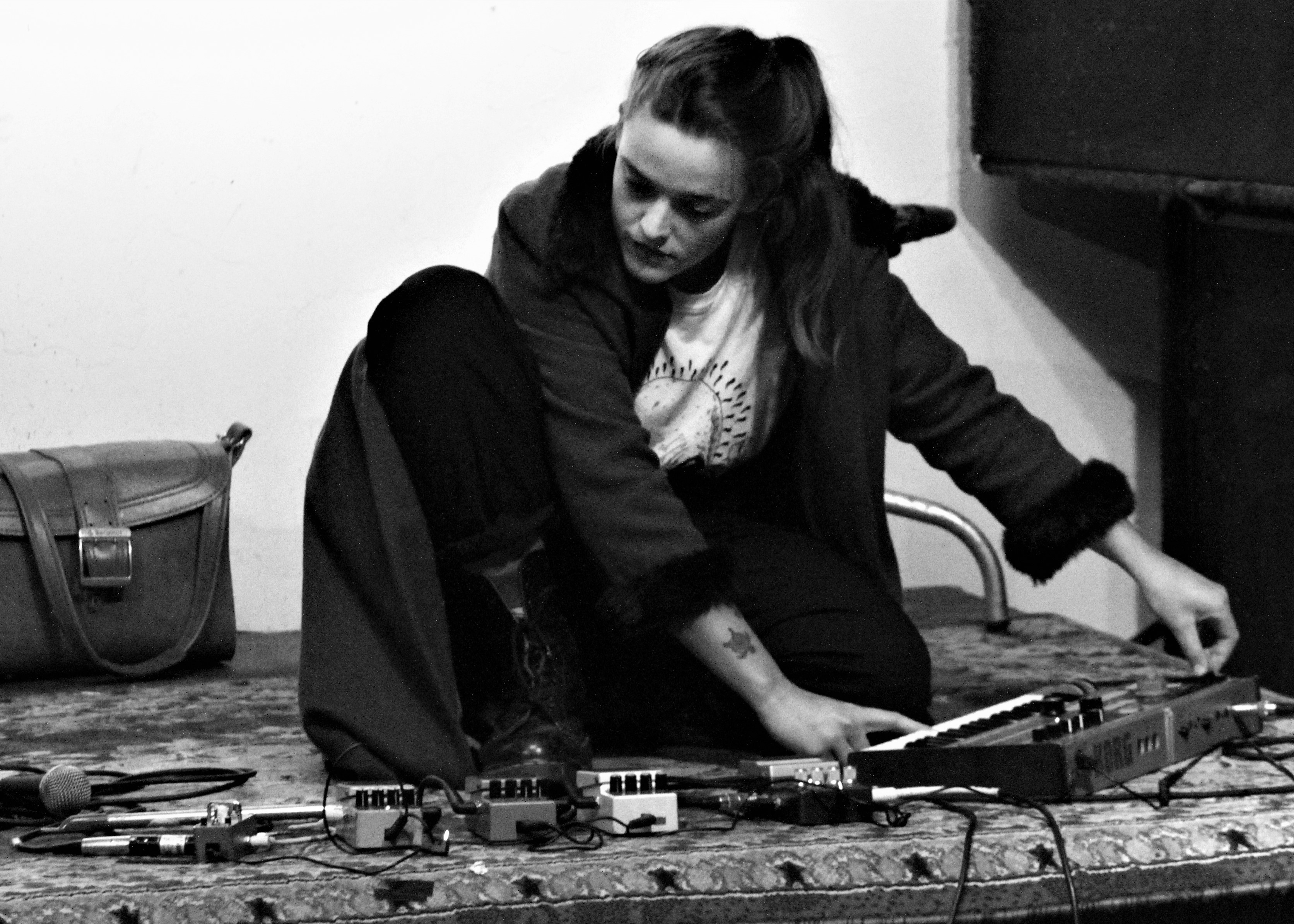
Aotearoa /New Zealand
The most prominent local manifestation of NIFI is the Auckland-based collective VitaminS, as I discovered to my delight back in n that rainy night in 2006. It was founded in 2002 by
composer and performer Andrew (Drew) McMillan after brainstorming the concept and
format with fellow musician Kingsley Melhuish on the long car journey back to Auckland
from a festival in Wellington.28 Drew continues to be a central pillar of the enterprise, keeping
it chugging along through the COVID pandemic and various other challenges.
According to their website it is, “A community of artists engaged in the dialogue of
creative improvisation.”29 It continues,
The Vitamin-S pool night was devised as a place where those interested in
improvised music and performance could meet, perform, listen to and
discuss, and generally interact with all aspects of this complex and largely
misunderstood art form.
The website goes on to make the following distinction:
︎ Idiomatic improvisation: much the most widely used and concerned
with the expression of an idiom - jazz or flamenco for example, and
taking its identity and motivation from that idiom.
︎ Non-idiomatic improvisation: here other concerns are fundamental. It
is usually found in so-called 'free' improvisation.
…emphasising that it is the latter form that is the focus of the group.
The definitions are very close to the form of words stated in Derek Bailey’s review of
improvisatory practices.30 Paul Buckton confirmed to me recently that this was in fact the
source for the text. As with the scene generally, there is a distinct paucity of scholarly
literature that describes or analyses the Vitamin S collective specifically.
This seems unfair, as my personal encounters with Vitamin S and its connected scenes
have led me to reassess my own approach to creativity, and given me opportunities to
express that, both via direct participation in the pool nights, and at other events. I contend that this
energising and empowering effect is not confined to me and deserves greater recognition,
documentation, and scholarship.
Vitamin S gets a passing mention in Home Land and Sea,31 and the group does have its
own Wikipedia entry where it is described as, “as a free improvisation collective” and “non-
profit collective”.32 Other than that, very little seems to exist, especially in the peer-reviewed
realm. Glenda Keam, former head of music at University of Canterbury and an occasional Vitamin S
participant herself, presented a short paper at the New Zealand Musicological
Society Conference 2011, based on interviews and observations conducted at four Vitamin S
evenings (she kindly shared her notes with me). She described the regular members as “an
interesting bunch, many of whom may also be seen and heard regularly performing as
musicians in other scenarios around town, building sculptures or teaching art, or working in
the caring professions.” 33
I previously conducted a short research paper based on structured interviews with a
selection of Vitamin S participants.34 My own (biased) observation, however, is that the
participants are overwhelmingly middle-aged, middle class white males with a tendency to
left leaning political outlook.35 Some of those observations are consistent with those of Keam
in her research; she points out, “Across the four Mondays, there were no female performers,
only male…Two thirds of the respondents [to her study] were Pakeha [sic] New Zealanders”
It was also my observation that, during the time I was a Composition student at
University of Auckland School of Music (2010-15), there was practically no interaction
between existing students (with the exception of a few from the jazz stream) or staff and Vitamin S;
and very little awareness of it as a thing (honourable exceptions: composers Eve
de Castro Robinson and John Coulter, and early music expert Kevin Kim). In contrast, it
seemed to me that there was more interest from Visual Arts students.
There is a chapter about Vitamin S in Bruce Russell’s Erewhon Calling36 (although in his
introduction to that book Russell points out that “… ‘music’ in New Zealand generally is
poorly served in terms of publications”) and the group itself produced a small informative
zine to celebrate its tenth birthday.37 Both of those accounts are largely concerned with
outlining historical information. The chapter in Russell’s book gives insight into the kaupapa
of the group:
There is no discussion, there is no rehearsal and there is no ‘let’s try that again’…
it is not an open mic night or jam session, it is not a place to try out composed
music, and it is not place which excludes performers from any musical genre.38
The 10 Year anniversary booklet contains a wealth of information about the history of the
group. Of note is the interview with founder Andrew (Drew) McMillan and Paul Winstanley
(once a regular participant but now relocated to the US) in which they discuss the origins of
the collective and its ethos. Their initial venue was the (now defunct) Odeon Lounge, then the Wine Cellar,
then the (now defunct) Luxembourg Gardens39 and is now firmly ensconced in
the Wine Cellar, with occasional forays to other venues (Including the Audio Foundation) for
special events.
The booklet also contains personal statements from participants about the practice of
NIFI that reinforce the idea of an inherent political framing locally. Renowned percussionist
Chris O’Connor comments, “[non idiomatic improvised music] represents the possibility of a
model society I am excited by.”40 Paul Buckton: “Every decision you make about your life
and how you live it is political.”41 Darren (Darridge) Hannah: “Improv is tied to broader
forms of democracy, in its social nature and rejection of hierarchy…Improv is inherently
political in nature, and its politics happen to match mine.”42
What happens at Vitamin S cannot be called ‘popular’ (typical audiences range from 5 to
20 people, in my experience) but neither has it been taken on board as serious art music in
terms of scholarly study in New Zealand. This is despite the fact that a good proportion of
those involved are professional musicians or art school graduates. Nevertheless, the group
has had small amounts of funding over the years from Creative New Zealand. This “outsider
music” is always on the edge.
Vitamin S has worked closely with the Audio Foundation. Founded in 2004 by Zoe
Drayton, the Audio Foundation exists “to support, promote and preserve ‘Sound
Art’ /’Experimental Music’ / ‘Noise’ / ‘Drone Music’ etc in NZ.”43 The Audio Foundation’s
current director, Jeff Henderson, is a frequent participant in Vitamin S, and was previously a
key figure in the experimental music scene in Wellington.
The range and background of the participants in Vitamin S is varied. It encompasses jazz
players, classically trained orchestral players, pop musicians, performance artists,
contemporary dance practitioners, and sonic artists, through to ‘outsider’ musicians with
limited formal training. There is no qualification bar to participation other than a willingness
to perform in a randomly constituted ensemble without rehearsal or pre-planning.
Keam, however, points out that the very idea of “non-idiomatic” is slightly problematic.
She reports Eddie Prévost (a founder member of the group AMM) as thinking that because the
general ‘sound’ produced starts to become recognisable, then it is, in effect, a new idiom.
Writing in No Sound Is Innocent, Prévost comments, “the conventions and practices that have
as risen in AMM are its signatures. They are signs of its identity: perhaps also of traps AMM
has failed to avoid.”44
On the other hand, (referring to AMM in particular), music writer Philip Clark disputes
that there is any consistent identifiable idiom or sound going on to say, “AMM… taps into a
centring flow of sound, which the musicians, as responsive listeners, can either uphold or
shift towards new ground. Each musician represents a separate layer of overlapping activity,
and the music procreates an accumulative structure as these jagged layers dance in
counterpoint to each other.”45 In my experience, this is also a pretty good description of a
typical Vitamin S set.
Bailey’s collaborator in the Joseph Holbrook Trio, drummer Tony Oxley also had doubts
about how “free” free was. He is reported in Watson’s book as saying:
The implication of free music is anything goes. You can say, do what you
like. But of course you are doing what you like, but what you like is not
just thrown in because you yourself don’t know what to do. You have what
you’re doing under control. You build a language and you work with that
language, you improvise with that language - hopefully it develops as you
go along.46
...which kind of reinforces what Keam asserts and one might relate this to Simon
Emmerson’s notions of action repertoire in relation to composition.47 Many of the people in
the Vitamin S scene have said to me that there is a certain ‘Vitamin S Sound’, so really it
depends on your own experience.
One of the central figures in the Vitamin S scene since its early days, Paul Buckton, (who
often acts as master of ceremonies and performs often on guitar and occasionally violin or
cello) serves as a direct link back to the UK scene that crystallised around Bailey, having
been involved in The Termite Club in Leeds in the 1980s. The Termite Club described itself
as “Maverick music from Leeds” and appears to have been briefly revived in 2014 (according
to an archived web page from Vibrations magazine).48
There are other improvised music scenes here in Aotearoa/New Zealand, notably in
Wellington (The Sound and Light Exploration Society and its related Pyramid Club); 49
described in a recent newspaper article as “legendary”.50 Until 2017, Christchurch had a
group based around The Auricle Gallery.51 Individuals from those groups (and from further
afield) have often been guest performers at occasional events or workshops organised by the
Vitamin S collective, and various Vitamin S participants have been invited to perform at
events and festivals organised by those groups.
This year (2022), Vitamin S celebrated its 20th anniversary with an exhibition at the
Audio Foundation, described as “an exhibition charting the history and development of this
grass-roots collective.”52 There were two accompanying limited-edition booklets produced in
house at the Audio Foundation - a photo book,53 and the transcript of a revealing interview
with Paul Buckton from 2012 (see below).54
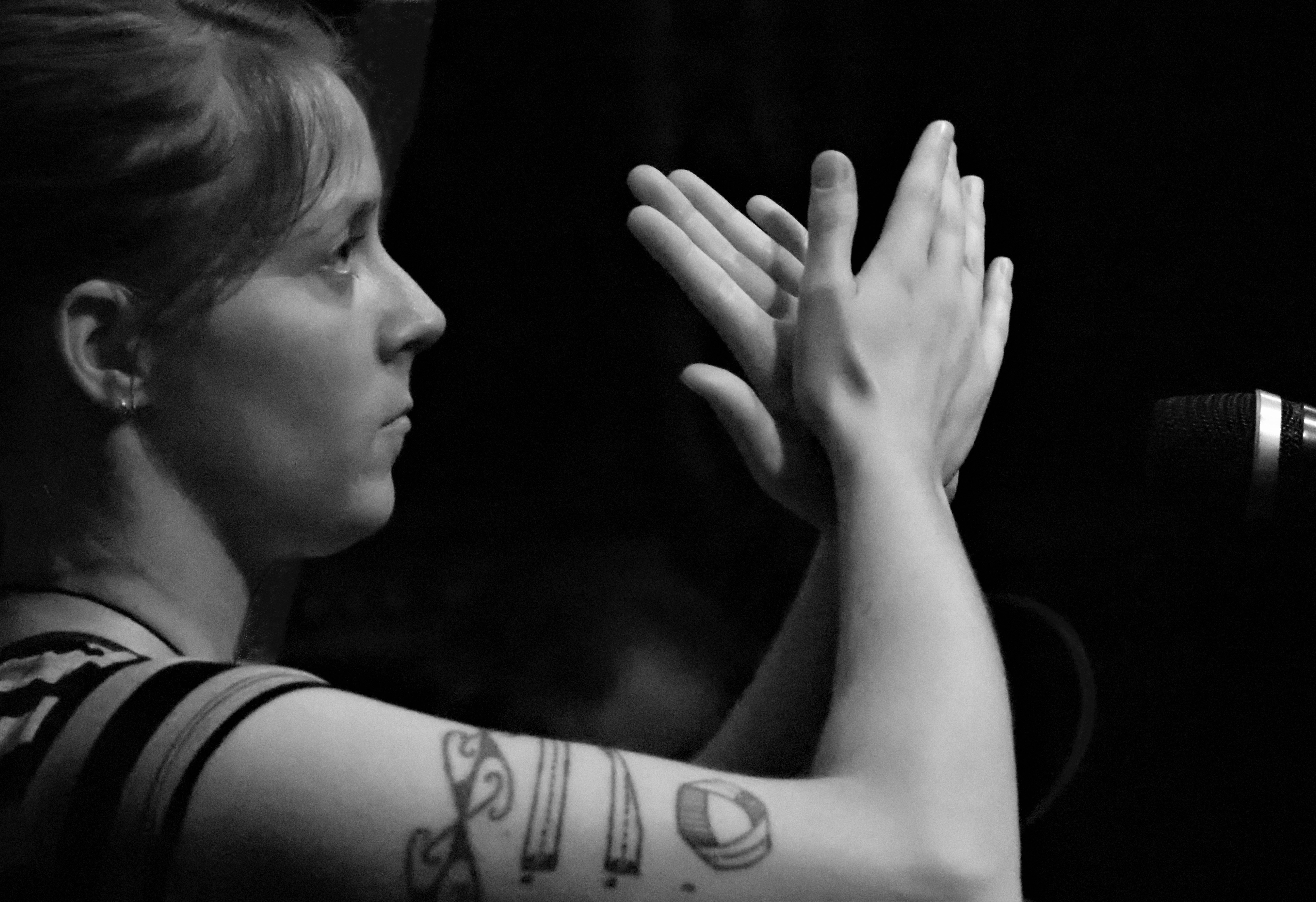
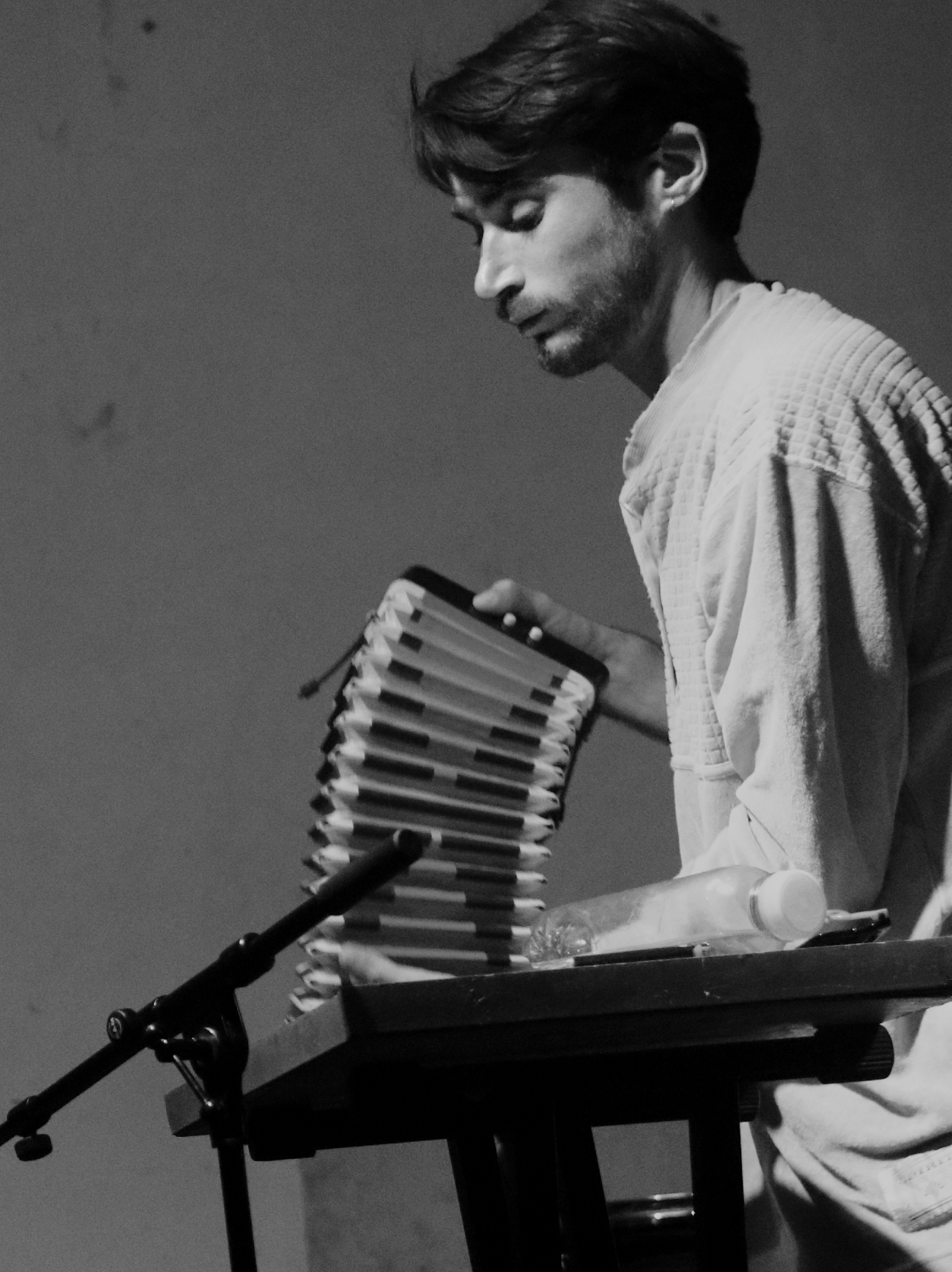
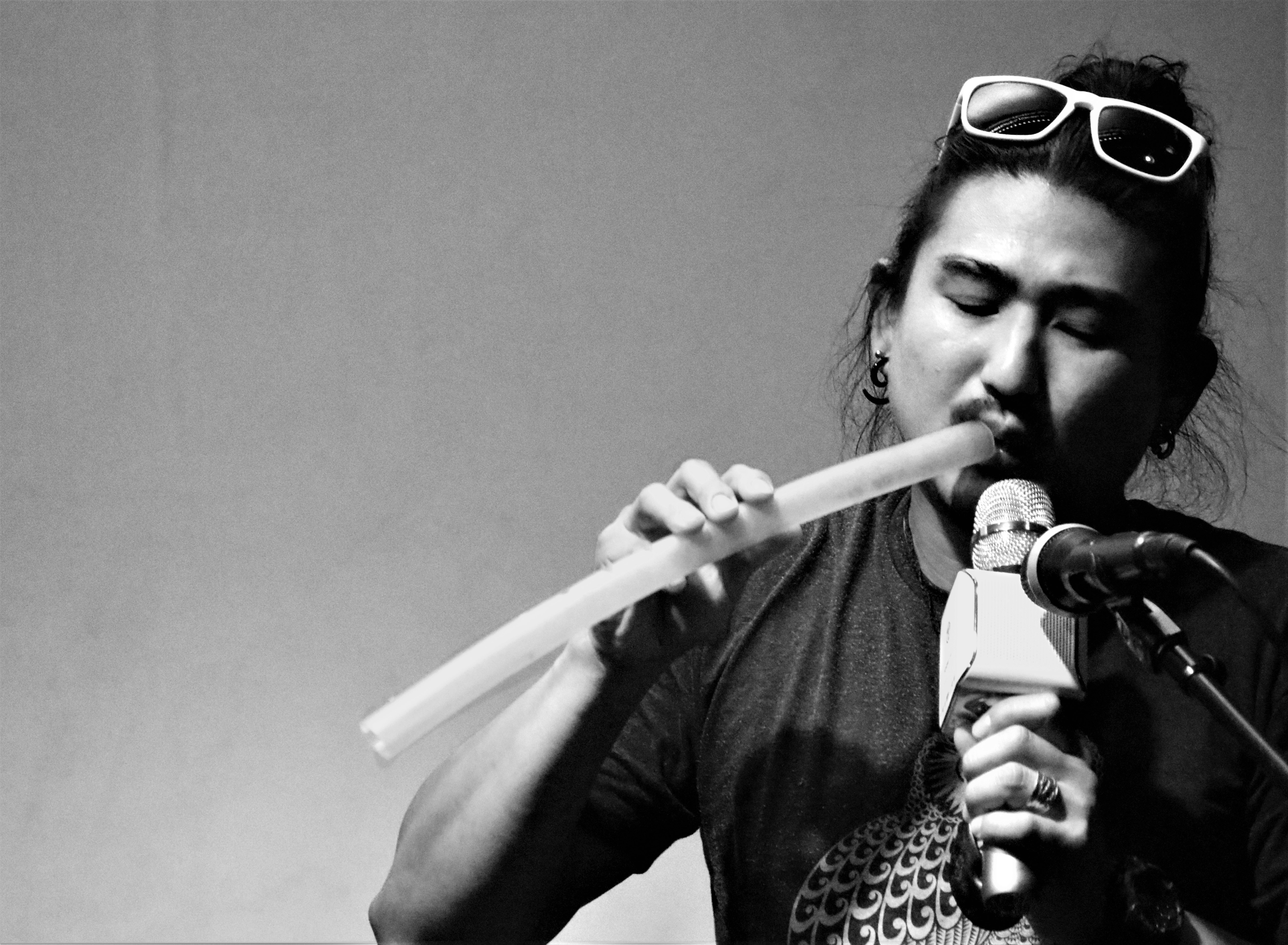
The Photo Book
(Full disclosure: there was a photo of me in the exhibition and one in the book) PaulBuckton is fond of the following quote, which (via Darren Hannah) he attributes to Bill
Watterson’s cartoon strip Calvin and Hobbes, to sum up the ethos of the group, it’s
reproduced in the Photo Book on the page before the pictures start. I find it amusing that
Waterson’s scenario, whilst attempting to satirise avant-garde music, ends up being embraced
as a form of truth.
Our music is about the inadequacy of traditional imagery and symbols to convey
meaning in today’s world. By abandoning representationalism we are free to express
ourselves with pure form. Specific interpretation gives way to a more visceral
response.
The main exhibition consisted of photographs taken over the past 20 years, mostly by
Paul Buckton, but with some contributions by long-time Vitamin S stalwart Derek Tearne.
They were all taken at pool nights or special events organised by the Vitamin S core team.
The collection movingly includes some performers who have sadly passed on. Faces familiar
to those outside the Vitamin S community in the collection include Phil Dadson, Richard
Nunns, Steve Beresford, Chris O’Connor, Rob Thorne, and Jim Langabeer. Naturally,
Drew’s recently departed service dog Biff, a much -loved serial and stoic attender of pool
nights, also features. The scope of photos in the book makes it a significant archival
document. As the exhibition website put it, “…these documents, snapshots in time, moments
out of order — grainy, blurry, blown-out, full of energy — provide a glimpse into this
community, their music and comradeship.”
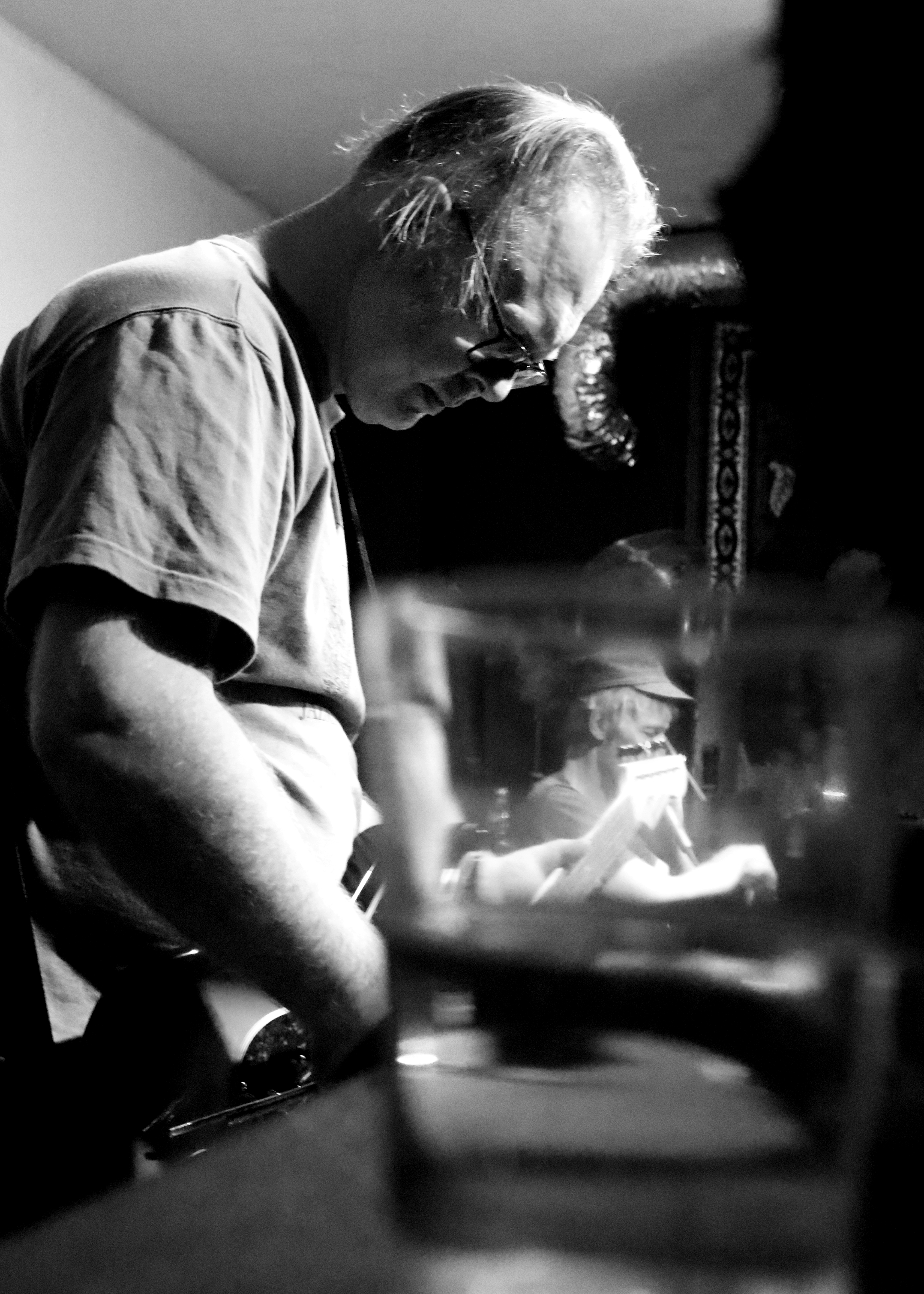
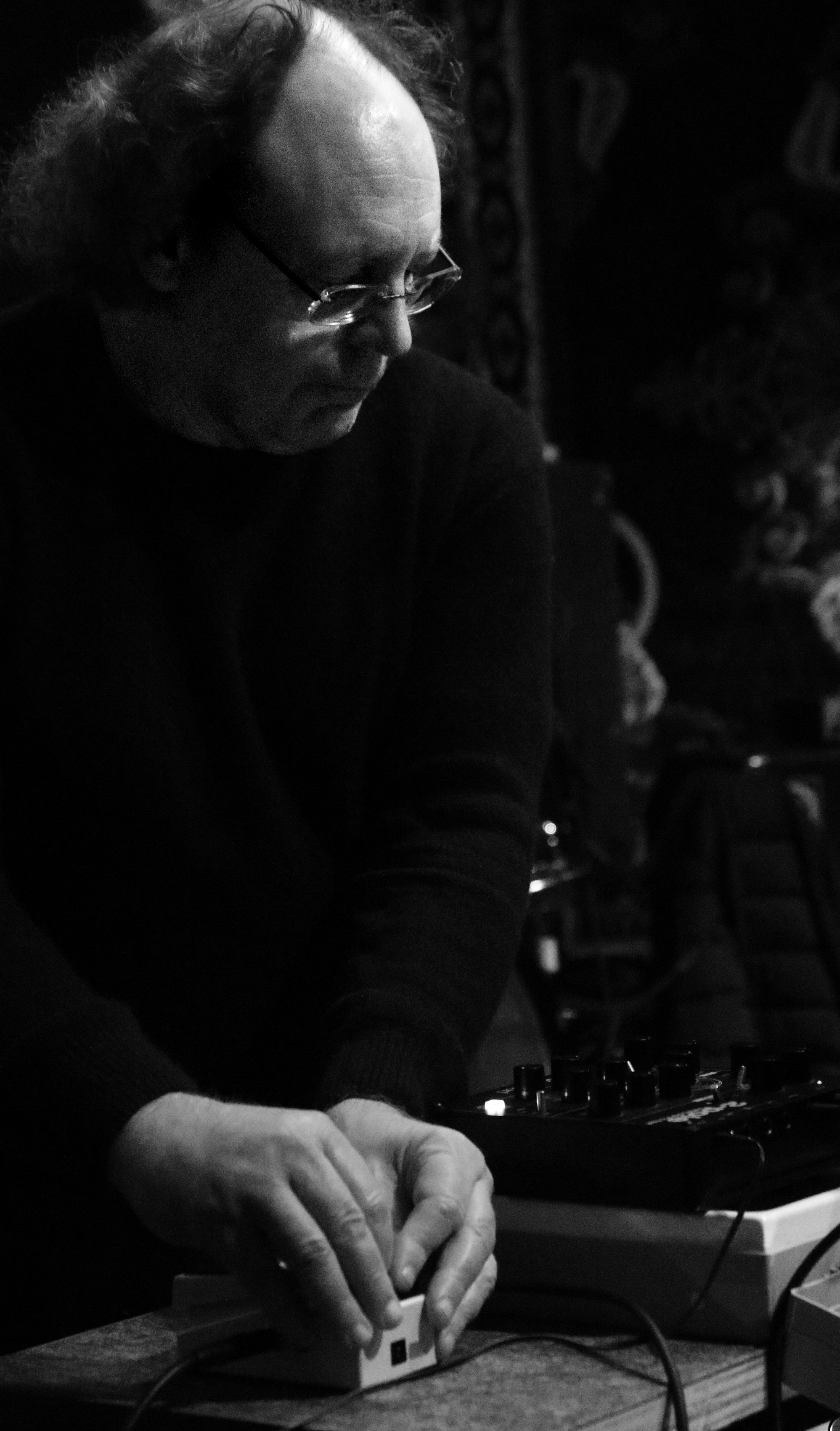
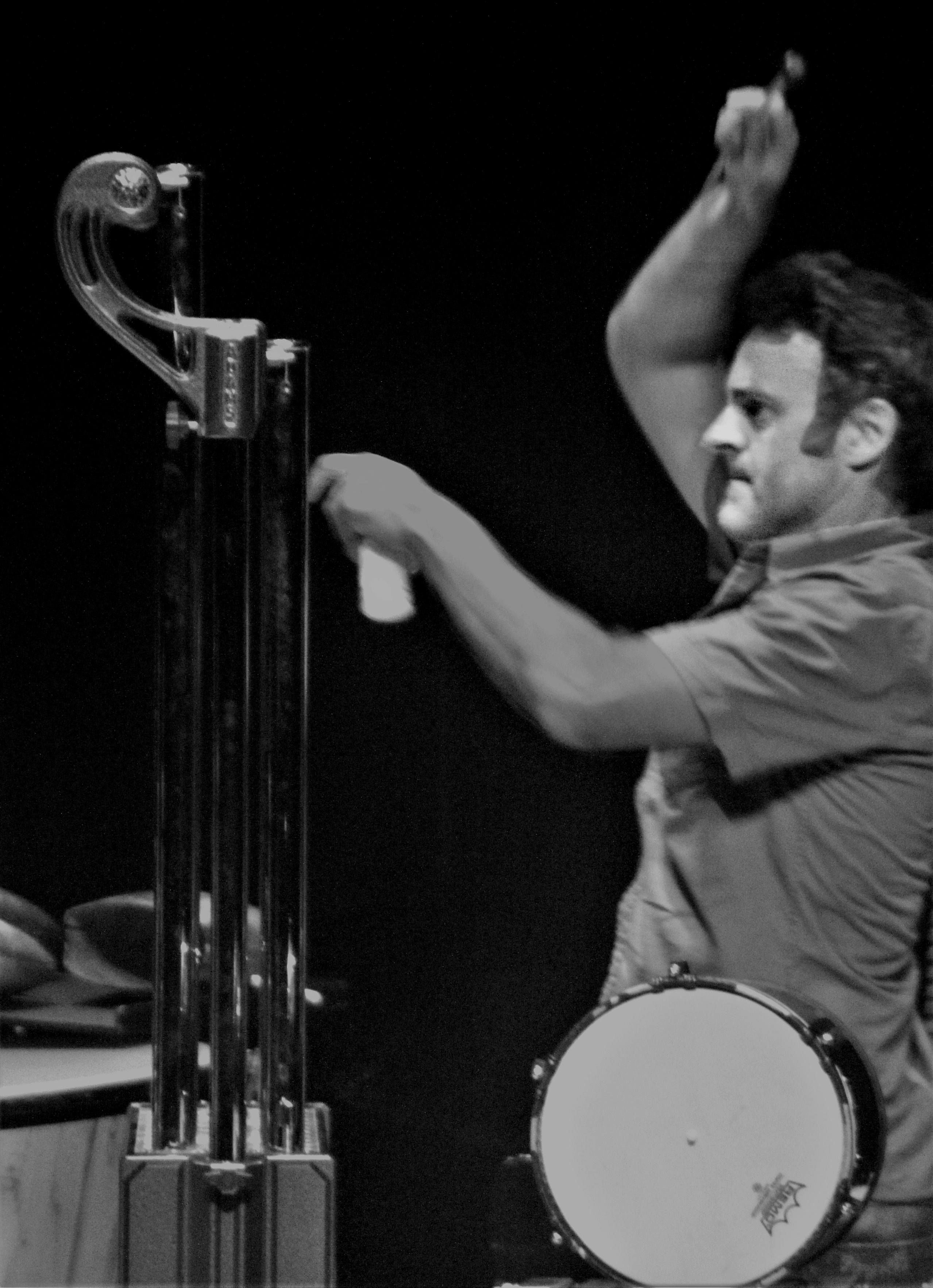
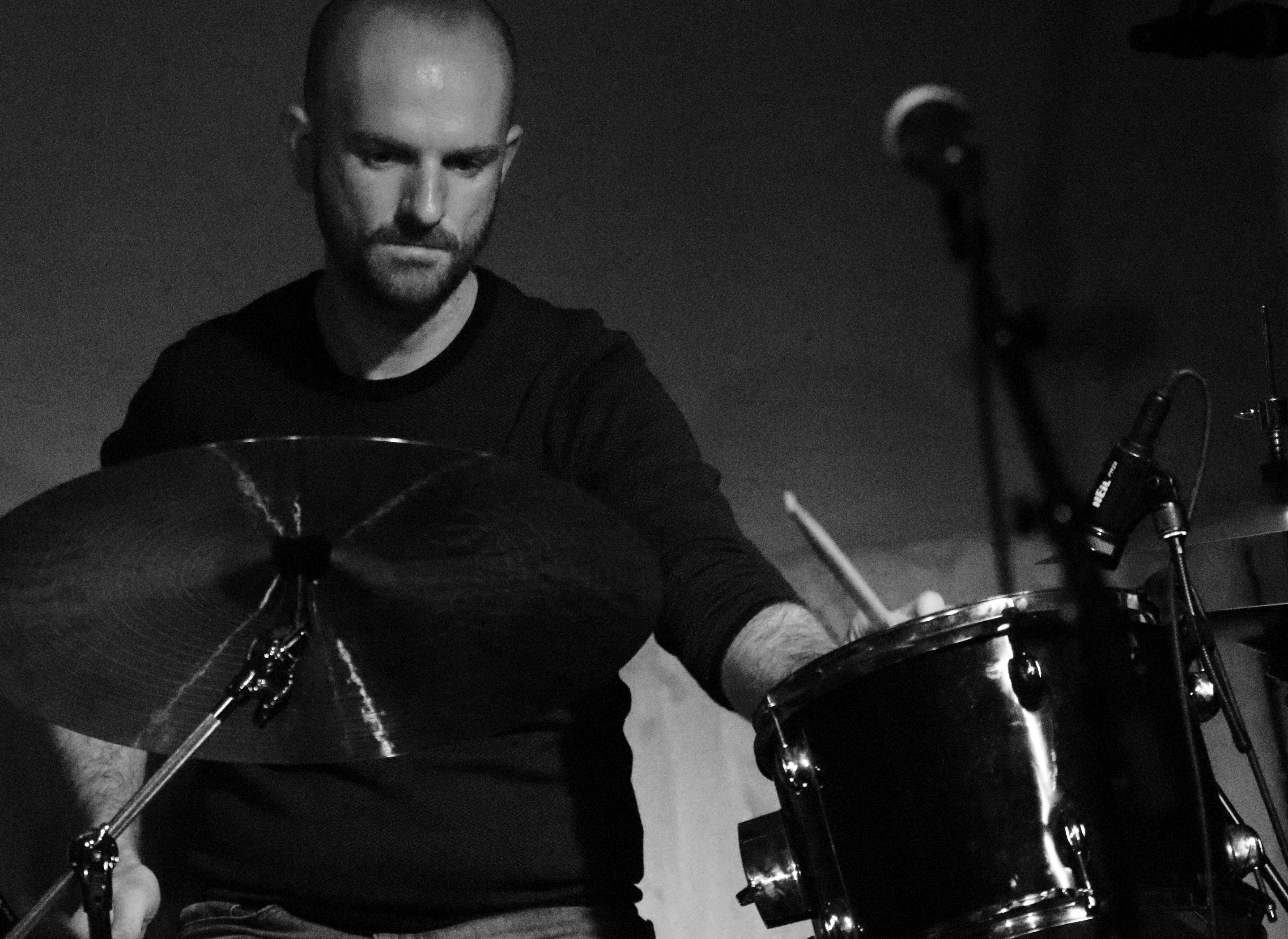
The Buckton Interview55
Paul Buckton is very much a cornerstone of Vitamin S, having been key participant since
early times of the group, in the cohort along with composer Andrew McMillan and Darren
Hannah. He ca
me to New Zealand to work as a teacher in 1997. At that stage he’d given up
playing after being involved with The Termite Club in Leeds for many years. Buckton, along
with his colleague Alan Wilkinson, had been instrumental in getting Termite up and running,
only ending his involvement after becoming disillusioned with the attitude of some of the
out-of-town players, who did not, it seems, fully acknowledge the work that went into
keeping it running, and took the hospitality of Paul and his family for granted. It would be
five years before the urge to play returned. In the interview, Buckton outlines the evolution of
Termite from a monthly gig night for alternative bands to a forum that focused more and
more on improvisation, name-checking Evan Parker, Steve Beresford, and Derek Bailey
along the way.
Buckton also describes playing violin with the Portsmouth Sinfonia in the mid 1970s,
travelling to London and meeting guitarists Derek Bailey and John Russell, and other people
in that scene.56 He says of the Sinfonia, “I would just sit there with 50 other people pretending
we could play this popular classical shit.”57 Buckton’s time with the Sinfonia included gigs at
the Royal Albert Hall.
Of his approach to creating improvised music he says, “you have to leave all your ideas
about what music is behind and just play.”58 He goes on to refer to Bailey’s idea that if too
many people started liking the performances, then somehow you have missed the point.
He considers Rohan Evans’ role in the stubborn persistence of Vitamin S to be very
important, “in all my improvising days, I’ve waited until I got to the Wine Cellar to find
somebody who owned a bar, and was into the music.”59 This is in contrast to his experience
with Termite in Leeds, where he recalls using “14 pubs in 12 months.” Even the COVID-19
pandemic could not suppress the enthusiasm of the group, as activities and pool night moved
to the virtual space of the internet and were live-streamed with pool participants in separate
locations, until the Wine Cellar was able to open again.
I should point out here that Vitamin S performances are often not confined to the realm of
sound. There is sometimes a component of deliberate visual theatre – whether this is the
object manipulation of sculptor John Radford (whose performances have included household
appliances, balloons, and coloured balls) or the involvement of various contemporary dancers
such as Georgie Goater, Val Smith, and Jess Quaid. Award winning dancer and
choreographer Kristian Larsen has been involved with the group since its early times and was
responsible (along with Drew McMillan) for a successful series of spinoff events entitled
Bangers and Mash in which each iteration saw two duos of musician pool members
collaborating with a dancer in an unscripted performance. McMillan has however expressed
the view that although it was easy to get musicians to participate in the dance events, it has
been harder to get the dance community to come along to Vitamin S pool nights.60
In Auckland, we are truly blessed that that particular set of individuals led by Drew
McMillan persevered to make the initial concept an ongoing and robust reality. Perhaps the
real key to the endurance of Vitamin S is its ability, on a rainy Monday night, to allow us to
be amongst friends and to focus on the frank and deliberate manifestation of this most human
and ancient of artforms, our small way of creating stubborn ripples across the degenerating
rhizomes of society, and to have a beer at the same time.
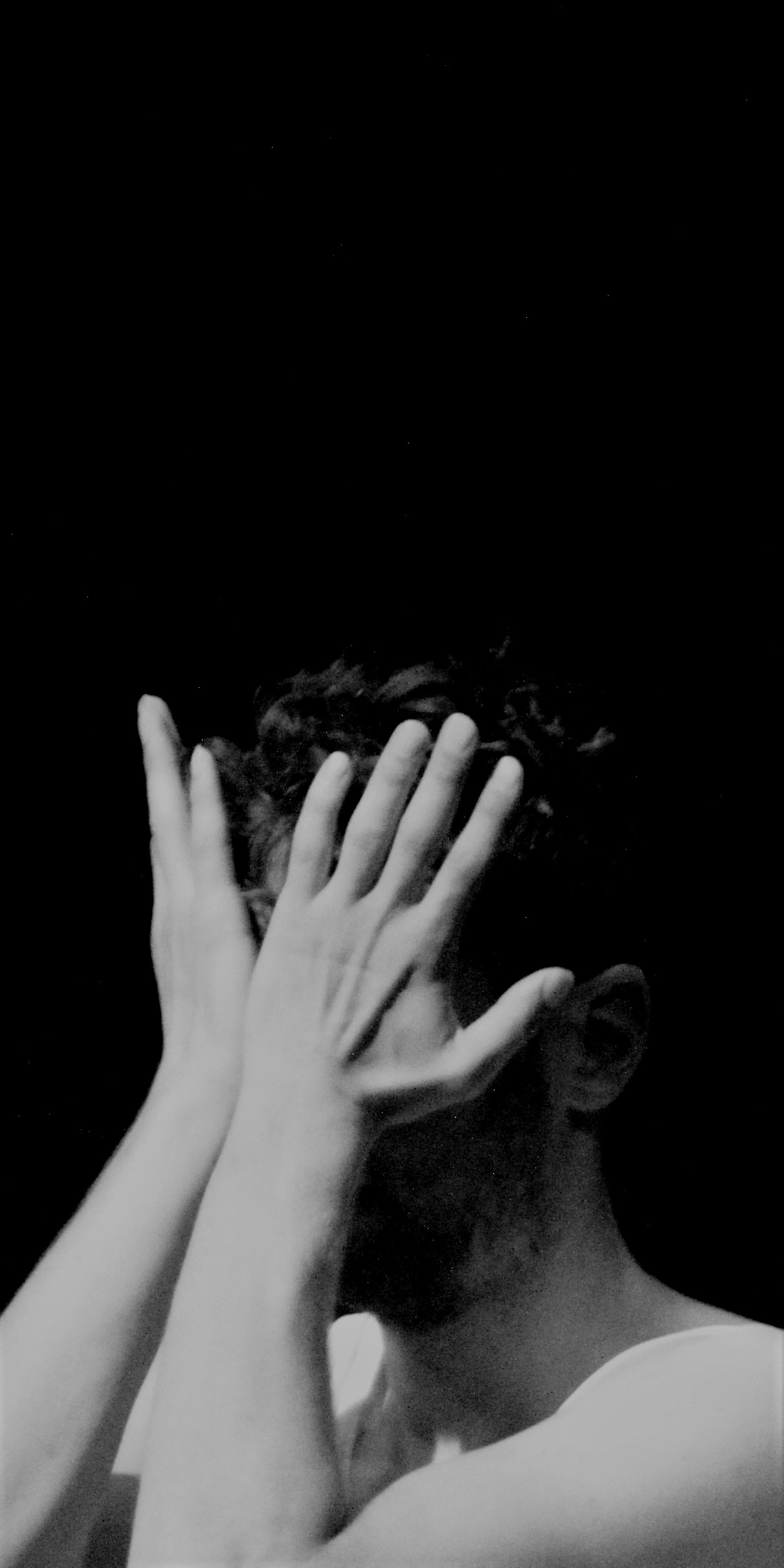
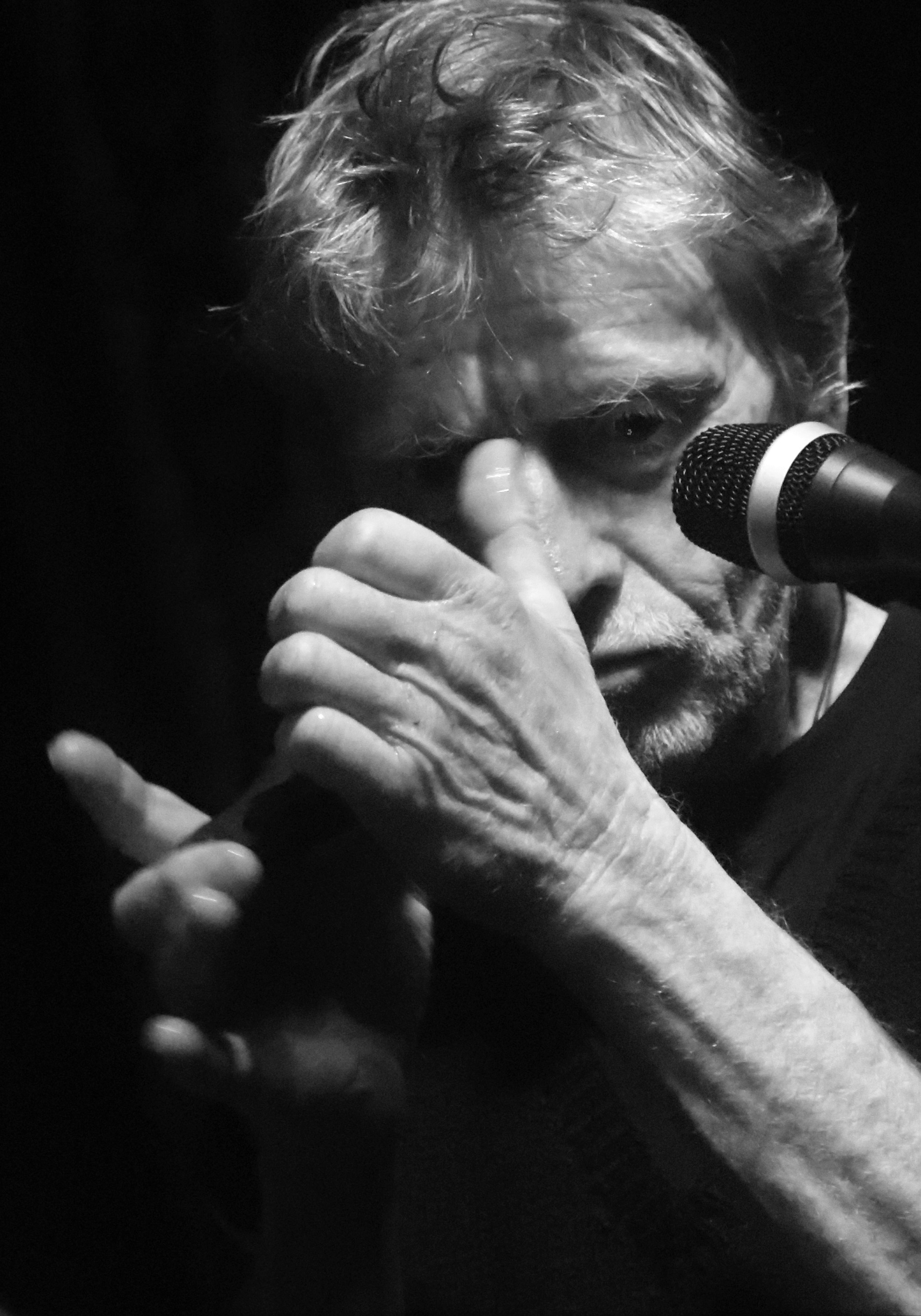
Acknowledgements
This writing is mostly based on work done as part of my research at AUT. I’d like to
thank the many participants in Vitamin S whose formal and informal discussions over several
years have helped me with this piece, including but not limited to: Drew McMillan, Paul
Buckton, Darren Hannah, and Audio Foundation Director, Jeff Henderson; also, Dr Nabeel
Zuberi (University of Auckland) for supervising some original research in 2015; Dr Glenda
Keam for sharing her conference paper notes; and my current PhD supervisors at AUT, Dr
James Charlton and Prof. Chris Braddock.
Colin James Woods
August 2022.
Photographs by Paul Buckton
1 Pierre Schaeffer, In Search of a Concrete Music, trans. Christine North and John Dack (Berkeley: University of
California Press, 2012), 3.
2 The Wine Cellar is an established bar and music venue which has been owned by Rohan Evans and his family
for 18 years. Rohan is famous locally as a tāonga of the local music scene, and for giving encouragement to
new bands, especially less popular and experimental genres. It gets its own chapter in Erewhon Calling.
3 David Toop, Into The Maelstrom: Music, Improvisation and the Dream of Freedom, 1st ed. (London:
Bloomsbury, 2016), 1.
4 Charles Ives, 114 Songs (Conn.: Redding, 1922).
5 Daniel Fischlin and Eric Porter, eds., Sound Changes: Improvisation and Transcultural Differences (Ann Arbor,
MI: University of Michigan Press, 2021).
6 Gillian Siddall and Ellen Waterman, eds., Negotiated Moments: Improvisation, Sound, and Subjectivity
(Durham: Duke University Press, 2016), 3.
7 Louis Arnaud Reid, ‘The Arts Within a Plural Concept of Knowledge’, in The Symbolic Order, ed. Peter Abbs
(London: The Falmer Press, 1989).
8 ‘Tohu Wakatipu (Exhibition)’ (Hundertwasser Art Centre, Whangarei, 2022).
9 Derek Bailey, Improvisation: Its Nature and Practice in Music, Rev. Ed. (London: British Library National Sound
Archive, 1992).
10 Ben Watson, Derek Bailey and the Story of Free Improvisation, Paperback edition (London ; New York: Verso,
2013), 2.
11 Watson, Derek Bailey and the Story of Free Improvisation, 3.
12 Bailey, Improvisation, 35.
13 Michael Nyman, Experimental Music: Cage and Beyond (Schirmer Books, 1974), 31.
14 Umberto Eco, ‘The Poetics of the Open Work’, in Participation: Documents of Contemporary Art, ed. Claire
Bishop (MIT Press, 2006).
15 ‘Nights’ (Radio New Zealand National, 22 June 2022),
https://www.rnz.co.nz/national/programmes/nights/audio/2018846887/dunedin-youth-orchestra-audrey-
reid-composition-competition.
16 Cardew was at various times a member of AMM.
17 Alex Ross, The Rest Is Noise - Listening to the Twentieth Century (New York: Farrar, Straus and Giroux, 2007).
18 Bruno Nettl and Melinda Russell, In the Course of Performance: Studies in the World of Musical Improvisation
(Chicago: University of Chicago Press, 1998).
19 James Andean, ‘Editorial: The Sonic and the Electronic in Improvisation’, Organised Sound 26, no. 1 (April
2021): 1–4, https://doi.org/10.1017/S1355771821000182.
20 Fischlin and Porter, Sound Changes.
21 Vijay Iyer, ‘Beneath Improvisation’, 2015, 1.
22 Claire Bishop, Artificial Hells: Participatory Art and the Politics of Spectatorship (Booklyn, NY: Verso, 2012).
23 Daniel Fischlin, Ajay Heble, and George Lipsitz, The Fierce Urgency of Now: Improvisation, Rights, and the
Ethics of Cocreation (Durham: Duke University Press, 2013), 1.
24 Gary Peters, ‘Bits and Scraps: Derek Bailey and the Improvised Situation’, in Improvising Improvisation: From
Out of Philosophy, Music, Dance, and Literature, (University of Chicago Press, 2017).
25 ‘Derek Bailey | the Interview | London 1975’, Bells | Free Jazz Journal by Henry Kuntz (blog), 25 May 2007,
https://bells.free-jazz.net/bells-part-two/derek-bailey-the-interview-london-1975/. 8
26 Fischlin and Porter, Sound Changes, 3.
27 Watson, Derek Bailey and the Story of Free Improvisation, 12.
28 Darren Hannah, ed., Vitamin S 10 Year Anniversary, Book, Edited (Auckland: Vitamin S, 2012).
29 Vitamin-S, ‘Vitamin-S’, 2021, http://www.vitamin-s.co.nz/about.php.
30 Bailey, Improvisation. xi
31 Glenda Keam and Tony Mitchell, Home, Land and Sea: Situating Music in Aotearoa New Zealand (New
Zealand: Pearson, 2011).
32 Anon, ‘Vitamin S’, 2015, https://en.wikipedia.org/wiki/Vitamin_S.
33 Glenda Keam, ‘Hot Pools, Permeable Membranes, and Play’, 2011.
34 Colin Woods, ‘Exploring the Nature, Value and Challenges of Vitamin S’ ((Unpublished), 2015).
35 I have retained the original audio and interview transcripts for future research and note here that the project
was carried out under supervision of University of Auckland.
36 Bruce Russell, ed., Erewhon Calling: Experimental Sound in New Zealand (Auckland: Audio Foundation /CMR,
2012).
37 Hannah, Vitamin S 10 Year Anniversary.
38 Paul Buckton et al., ‘Vitamin S: Get in Get Wet- a Format for Improvisation’, in Erewhon Calling (Auckland:
Audio Foundation /CMR, 2012), 84.
39 Described as, “a new performance venue in the heart of Auckland city. It operates as a centre of artistic
residence for performing arts companies, run by and for those companies.” See:
https://www.thebigidea.nz/node/172712
40 Hannah, Vitamin S 10 Year Anniversary, 20.
41 Hannah, 21.
42 Hannah, 25.
43 ‘The Audio Foundation’, Audio Foundation (blog), accessed 22 July 2022,
http://www.audiofoundation.org.nz/about.
44 Edwin Prévost, No Sound Is Innocent (Harlow, Essex,UK: Copula, 1995), 25.
45 Philip Clark, ‘AMM’, in The Wire Primers: A Guide to Modern Music, ed. Robert Young (London: Verso, 2009), 114.
46 Watson, Derek Bailey and the Story of Free Improvisation, 66.
47 Simon Emmerson, ‘Composing Strategies and Pedagogy’, Contemporary Music Review 3, no. 1 (January
1989): 133–44, https://doi.org/10.1080/07494468900640091.
48 ‘Vibrations Magazine’, accessed 13 September 2021,
https://web.archive.org/web/20151031163610/http://www.vibrations.org.uk/features.php?fn_mode=fullnew
s&fn_id=782.
49 ‘THE SOUND and LIGHT EXPLORATION SOCIETY’, accessed 3 May 2022, http://www.soundexplorers.co.nz/.
50 Sam Buchanan, ‘Wellington’s Legendary Pyramid Club Gives Space to the New’, Stuff, 11 May 2022,
https://www.stuff.co.nz/entertainment/arts/300584272/wellingtons-legendary-pyramid-club-gives-space-to-
the-new.
51 ‘The Auricle Sonic Arts Gallery | Christchurch Ōtautahi NZ 2013-2017’, accessed 3 May 2022,
http://auricle.org.nz/.
52 Paul Buckton, ‘Is This Thing On? 20 Years of Vitamin S (Exhibition)’ (Audio Foundation,Auckland, NZ, 2022).
53 Audio Foundation, Is This Thing On? 20 Years of Vitamin S (Photo Book) (Auckland, NZ, 2022).
54 Darren Hannah and Jeff Henderson, Paul Buckton Interviewed (Auckland, NZ: Audio Foundation, 2022).
55 An earlier version of the interview appears in the 10th Anniverary booket.
56 Portsmouth Sinfonia: “The self-proclaimed ‘world's worst orchestra’ was founded by Gavin Bryars in 1970
when he was lecturing at the Portsmouth School of Art… Anyone could join, regardless of skill.” Famous
members included Brian Eno. Source : https://www.discogs.com/artist/442169-Portsmouth-Sinfonia]
57 Hannah and Henderson, Paul Buckton Interviewed, 6.
58 Hannah and Henderson, 26.
59 Hannah and Henderson, 27.
60 Woods, ‘Exploring the Nature, Value and Challenges of Vitamin S’.
